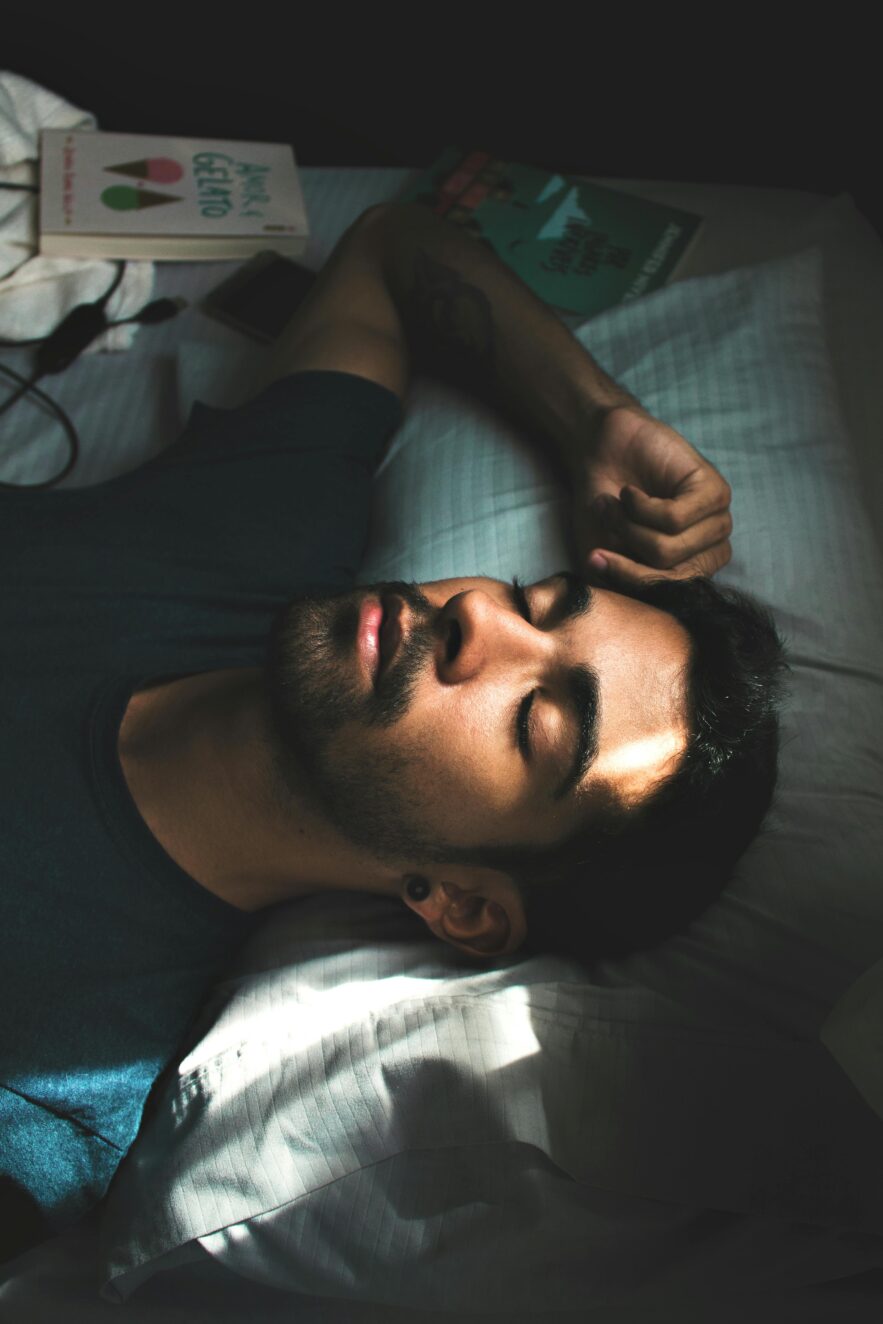Dr. Surrinder Paul Singh, MB, BS, BSc struggled with a drug called Stilnox (sold under brand names in the United States such as Edluar, Zolpimist, Intermezzo, Ambien CR, and Ambien; Stilnox in Australia) and its side effects. Here, he shares his personal account of how one little white prescribed sleeping tablet, barely larger than a grain of rice, almost ruined his life.
About The Conscious And Awake Me
I’m a medical doctor and have spent most of my professional life as a hospital shift worker. Many of my duties have been conducted during unsociable hours. Even a weekend off or a prolonged relaxing holiday remains alien to me.
During years of brutal study at medical school, I often pulled “all-nighters” to cram before exams. Caffeine was my go-to answer to get through volumes of textbooks learning about human structure, function, and pathology.
When I qualified as a doctor, endless nights on-call were the norm. I would always sleep with eyes and ears half-open, waiting for my pager to bleep that signalled I had to attend to a sick patient immediately, regardless of the time of day.
After 20 years of working hospital shifts, mainly in the chaotic environment of the ER, I eventually became a victim of a condition known as Sleep Work Shift Disorder (SWSD), a type of circadian rhythm disorder that affects people who work non-traditional hours.
What Exactly Is SWSD?
For anyone who has ever taken a long-haul flight, it can only be described as experiencing a permanent state of jetlag. Night appears day, and vice versa, like a disorientating clash between body and time. Exhaustion and confusion can intertwine, leaving your body muddled between two worlds of wakefulness and slumber.
SWSD throws your body’s natural circadian rhythm into disarray, causing you to struggle with sleep when you know your body craves rest and recovery.
- Insomnia: difficulty falling asleep or staying asleep. It typically affects people differently, depending on when they work. For example, people with SWSD who work between 4 a.m. and 7 a.m. often have trouble falling asleep, while those who work in the evening tend to have issues staying asleep.
- Hypersomnia: excessive sleepiness at unwanted times. This often occurs when a person with SWSD is at work during the night or early morning hours and can be dangerous, impairing work performance.
- Difficulty concentrating
- Headaches
- Lack of energy
- Decreased alertness while working
- Mood changes, including depression and irritability
Sleep Is Sacrosanct
It is common knowledge that sleep is a vital component of our lives. With it, we are more efficient, rational, and human. And I am no exception, especially as my profession demands sound judgement as we take patients’ lives into our own hands.
As I was displaying nearly all of the symptoms of the above, through self-diagnosis, I eventually consulted my family physician. After all, doctors are also human and need to turn to other doctors when they’re not coping.
A failure to recognise the symptoms of SWSD and seek professional help means many people plagued by the condition may turn to excessive daily alcohol use or resort to illicit substances to combat the effects of it. I most certainly do not engage in either, for it is not the fabric I am made of at all.
So, it was suggested I take a short course of a sleeping medication called Stilnox (Zolpidem) to be taken as needed. The usual dose is 10mg, taken before bedtime. The box was also labelled with the standard warning of not imbibing alcohol or operating machinery when taking it. I had no problem with that.
I welcomed any medication that would help me as my bouts of insomnia had begun to haunt me. A miracle drug, they called it, which I believed.
The initial days and nights of taking Stilnox were bliss; I would throw out those “Zzzs” uninterrupted for hours, leaving me feeling rejuvenated before my next shift.
Stilnox melted away my insomnia, inviting a sweet, deep sleep that had eluded me for years. It was the balm for my tormented soul, the key to unlocking a world of peaceful dreams.
But soon, the dreams invaded my reality as I slowly descended into a personal nightmare. But at the time, I didn’t realise the actual cost this “supposed saviour” would have on my personal and professional life.
The trap between reveries and reality reared its ugly head
From Dream to Nightmare with Ambien
It started subtly – a strange dish in the sink, misplaced car keys, and unfamiliar phone calls from my cell phone I had no recollection of making.
I initially wrote these actions off as my forgetfulness, a side-effect of my former sleep-deprived state. Then, one morning, I woke up with my night clothes back to front and found a half-eaten, partially frozen pizza on my bedside table. The adjacent lavatory to my ensuite bathroom had also been used but needed flushing properly.
I lived alone, separate from my partner, so nobody else was in my secure apartment. With sluggish eyelids, I peered at the plate, bemused, having no recollection of how it had got there. Moreover, I cannot bear hot pepperoni with a pineapple combo.
This was the beginning of a series of unnerving nocturnal and diurnal events.
My hours of slumber became a stage for my sleep-induced alter ego. During states of parasomnia, I’d prepare bizarre meals from random ingredients, start vacuum-cleaning my carpets, and even dial my family at all hours.
On consciously “waking up,” I would look at the log of my outgoing calls to find what had become a new mystery – what had I said or done during my semi-conscious state?
One concerning text I received from a work colleague really worried me.
It read, “Surrinder, can you please not call me when you’re drunk, as you made no sense?
Much appreciated. By the way, you’re a terrible singer – lol.”
The absolute horror lay in the fact that I had no memory of these events and had not touched a drop of alcohol!
It was as though my body had operated independently of my conscious mind. Stilnox had turned me into a somnambulist – a sleepwalker, trapped in a dream-like state, oblivious to the reality around me.
“Z” is for Zolpidem, “Z” is for Zombie
The events peaked when I found a series of emails I had supposedly written to my work colleagues — misspelt, inappropriate, nonsensical, and potentially career-ending. I was mortified. Yet, I had zero recollection of writing them.
My life was spiralling out of control, and Stilnox was at the helm, but naively, I was unaware at the time. The drug that was supposed to be my salvation threatened to implode everything I held dear; the fear of what I might do next haunted my waking hours.
My partner, who was overseas on a prolonged business trip, also became alarmed. He didn’t comprehend, nor did I. How could I explain something I couldn’t remember doing?
I slowly found I wasn’t “me” anymore, but a Stilnox-induced, zombie-like version of me — a version I didn’t recognise and could not control. I was stricken with intense paranoia regularly, as it seemed I had developed some form of split personality.
In the meantime, I am indubitably grateful that I had never harmed a patient under my care.
I made another appointment with my family physician; she was shocked at the severity of my reaction to Stilnox when I told her what had been happening. Immediately, she recommended I stop taking it.
But with the fear of sleepless nights overwhelming me, I wondered if I could handle the insomnia again.
A Rocky Road to Recovery
I really had to try to get off of this medication. The only alternative was losing myself entirely.
The process was gruelling. Withdrawal from Stilnox was not at all easy. My insomnia returned with a vengeance, but I was determined. The terror of what my life had become under Stilnox’s influence was a powerful motivator.
I began exploring alternative remedies for my sleep issues. Even more yoga, meditation, herbal teas, and essential oils — I tried them all. Some worked better than others, but each was a step away from the hypnotic drug that was destroying me completely. The journey was painful, full of long, sleepless nights and tiring days.
But, I was determined to regain control of my life from the spectre of a Stilnox-induced state that had wreaked havoc on my life.
I then started sharing my experiences and listening to others. I started researching even further about Stilnox, and found that in 2013, the FDA ordered that manufacturers of Stilnox change their dosage recommendations. This was in response to over 700 reports of zolpidem-related driving accidents, including drowsy and sleep driving.
I found reading this information healing, for I finally knew I wasn’t alone and that others had walked this precarious path.
Professional counseling became a regular part of my routine. I needed to understand my insomnia and what was happening inside my mind.
My counsellor provided tools and strategies to manage my sleep anxiety, helping me reframe my thoughts and concerns about sleep.
I also dove into a healthier lifestyle. Regular exercise helped tire my body out naturally, while a balanced diet and reduced caffeine intake aided my body’s internal clock. I learned the value of a consistent sleep schedule, and slowly but surely, my body began to adhere to it.
The progress could have been faster, and the path was fraught with challenges. Some nights, it felt like my insomnia was laughing at my feeble attempts to conquer it. But every morning, even after a few hours of sleep, was a victory, a sign that I was beginning to regain control.
Since I quit Stilnox three years ago, my life has been on the mend.
I still have occasional sleepless nights, which are no longer the norm. I no longer fear sleep, nor do I dread the mysterious actions of my sleepwalking self.
The terror Stilnox induced is finally a dark chapter in my past.
If Only I Could Turn Back the (Body) Clock
In retrospect, I realise that my desperation for sleep had closed my eyes to the potential dangers and side effects of Stilnox.
I don’t blame my family physician; it’s a legitimately prescribed drug that works well for many. But it was a life-shattering experience that almost cost me everything, including my life.
My journey with Stilnox has taught me the importance of being informed about what I put into my body and scrutinising any product information inside the medication box even more carefully.
It made me realise that quick fixes often come with steep prices. While I wouldn’t wish my experience on anyone, I’m grateful for the lessons it has taught me.
My narrative is a cautionary tale for those battling insomnia and considering medication. Sleep is crucial, but not at the cost of your sanity. There are alternative paths to managing insomnia. They may be more challenging, require more commitment, and take longer to show results.
My go-to remedy is now the occasional melatonin (available over the counter) or Valerian root (Valeriana officinalis), both of which are non-addictive. A 2020 review of 60 studies concluded valerian could be a safe and effective treatment to promote sleep and prevent associated disorders. Some evidence even suggests that valerian supplements may improve symptoms related to Obsessive Compulsive Disorder (OCD), menopause, and PMS, as well.
By taking the more natural route, I stand stronger and wiser today and am also more compassionate towards myself and others battling sleep disorders.
Though my journey continues, I try to sleep every night with the unwavering belief that I am more than a victim of random prescriptions.
I define myself by my resilience and determination to reclaim my life fully. Each day brings me closer to embracing the tranquillity and vitality I feel I deserve.







